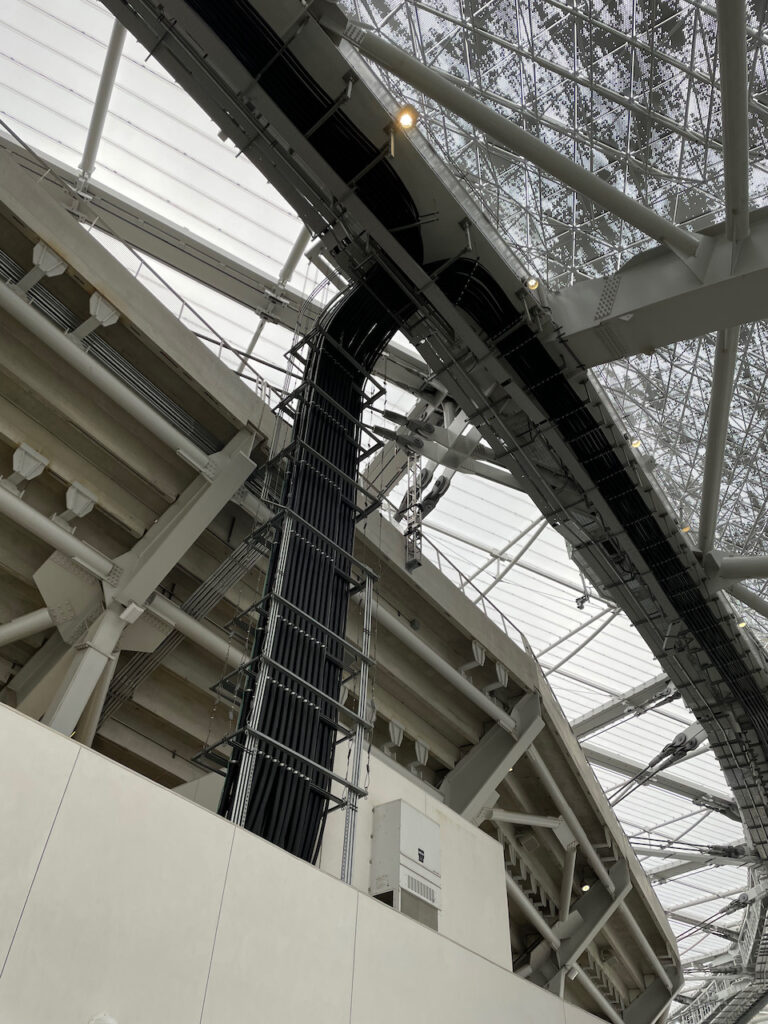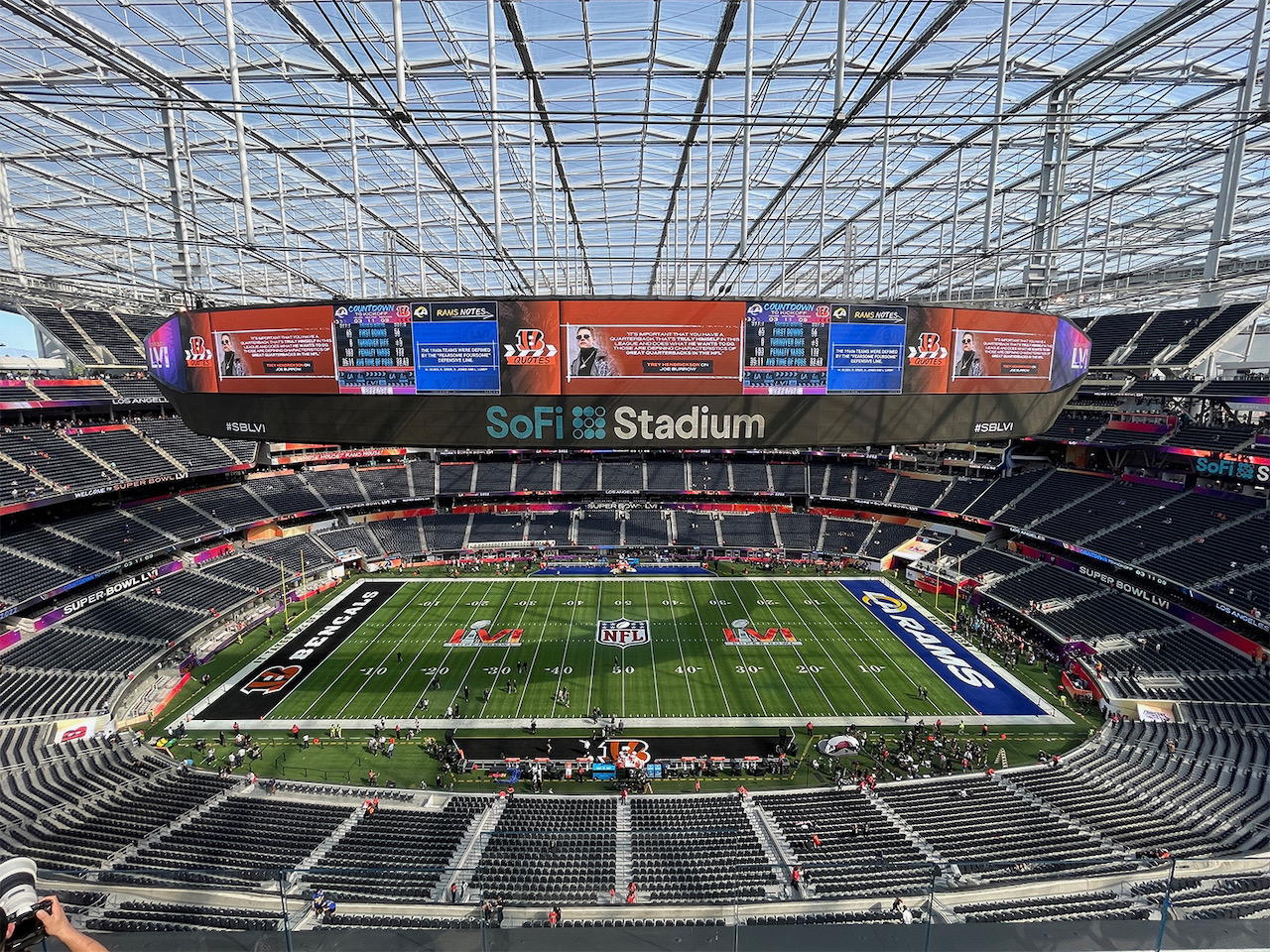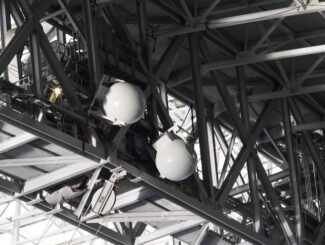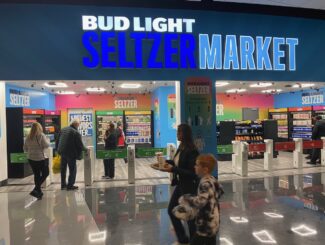In what has come to almost be expected, Super Bowl LVI at SoFi Stadium set a record for fan usage of Wi-Fi. But the number that stole the show at the NFL’s 56th “big game” was 53 — as in 53 petabytes — the amount of traffic carried by the stadium’s converged IP network that day.
According to statistics from Cisco, whose networking gear is used in every phase of SoFi Stadium’s network, from core switches to Wi-Fi 6 access points to the video broadcast IP media fabric, the overall network throughput averaged 5.1 terabits per second (Tbps) in the hours leading up to and following the game, and averaged 12.1 Tbps during the actual Super Bowl itself, leading to the final total. And in case you need a refresher, one petabyte is equal to 1,000,000 gigabytes, or 1,000 terabytes.
As perhaps the stadium with the single largest such converged network — and the only one with the content-devouring Infinity Screen by Samsung video board — SoFi Stadium may have set a high-water mark for total network usage that may be hard for any other single building to approach. But more important perhaps than the raw numbers from the game is the proof that converged IP-based networks can indeed support the highest demands of all network systems in a large venue, and can do so at a much cheaper cost and with easier management than the traditional deployment of separate networks for each service.
The huge demands of video, all on an IP network
Editor’s note: This post is from our Stadium Tech Report Spring 2022 issue, which you can read online, or download a PDF of the full report.
According to a blog post by Matt Swartz, a distinguished engineer within Cisco’s customer experience organization, the truly mind-boggling numbers came in large part from the video demands of SoFi Stadium’s big board as well as its 2,500 IPTV screens, which include 300 outdoor signs in and around the stadium and the surrounding Hollywood Park development.
According to Swartz, during the Super Bowl the broadcast network by itself was processing 24 Tbps, throughput made possible by the Cisco IP Media Fabric in the venue. For IPTV needs specifically, the network was running 2.5 gigabits per second of multicast traffic, bringing full uncompressed 4K feeds to every connected screen.

The all-Cisco Wi-Fi 6 network, the largest in any stadium, set new records for single-day Wi-Fi usage, with 31.2 TB recorded, according to statistics provided by Extreme Networks. Super Bowl LVI also set a record for the highest percentage of unique Wi-Fi device connections with 57,618, which out of the 70,048 in attendance made for a “take rate” of 82 percent. Previous high Wi-Fi “take rates” seen include 71.5 percent at Ohio State’s Ohio Stadium on Oct. 5, 2019 (where overall Wi-Fi data used was 25.6 TB) and 71 percent at Super Bowl 54. This year’s game also set a new high mark for peak Wi-Fi network throughput, at 20.7 Gbps, almost double the peak throughput of 10.4 Gbps seen at Super Bowl LIV.
Converged networks represent the future as stadium technology needs grow
Led by Skarpi Hedinsson, chief technology officer, SoFi Stadium and Hollywood Park, and master technology integrator AmpThink, the networking and compute environment deployed inside the building (as well as in Hollywood Park’s neighboring retail, commercial and residential area) is unlike most large venues, where different systems typically exist in their own silos, often with their own separate and different network.
Instead, the SoFi Stadium network brings all building functionality – including the wireless networks (among the largest built anywhere), the server compute platform, the telephone system, the IPTV network, the indoor and outdoor digital signage (including the massive oval dual-sided 4K main videoboard), the television broadcast systems, and the building management systems – into one converged platform, with a single vendor/single format structure, using Cisco gear in all places.
“We hyperconverged storage and the compute block, which had never been done in a building like this,” Hedinsson said. “It allowed us to take 80 or 90 physical servers out of the design — things that were slated to run everything from access control systems to lighting control systems. We virtualized all of that.”
If you poke your head inside older sports venues, you are most likely to see separate networks and operation centers for many of the different systems – wireless, wired networks, broadcast, and building operations. Historically the case has been made that those who know those systems best are responsible for building their operations – but the silo approach often brings headaches to those in charge of overall operations for the venue as a whole, as they deal with the proliferation of different systems to operate and manage.

In a Cisco blog post from last year, Hedinsson said the unique single-network deployment inside SoFi Stadium was not built simply to run up big numbers like the Super Bowl statistics, but instead as simply a better, easier way to run a venue.
“We hyperconverged storage and the compute block, which had never been done in a building like this,” Hedinsson said. “It allowed us to take 80 or 90 physical servers out of the design — things that were slated to run everything from access control systems to lighting control systems. We virtualized all of that.” Using 120 virtual machines, SoFi’s operations team can now run every single operational technology application in the building as well as some enterprise technology applications, Hedinsson said. “At the same time, we dramatically upgraded the manageability and the security envelope of our network. What this all translates to is we have time to pay attention to the things that we should be paying attention to: customer experiences.”








